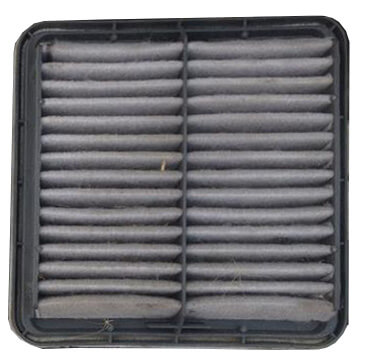Can You Clean An Engine Air Filter and does it really help?
You can clean an engine air filter, but it really doesn’t help much
If you’ve done any Internet searching you’ll see lots of articles telling you how to clean an engine air filter. If cleaning and reusing your engine air filter makes you feel good and allows you to think you’re doing a good thing for your engine, knock yourself out. In other words, you can go through the motions to clean an engine air filter. But in reality, removing the surface dirt won’t do much to improve filtering. Read more to find out why it doesn’t help much.
The engine air filter cleaning methods shown on the Internet
• Smacking the air filter on a hard surface
• Using compressed air to blow out particles from the backside of the filter
• Using a shop vacuum to suck the dirt out of the filter
• Washing a polypropylene filter and letting it dry
How an air filter traps dirt
Engine air filters have two layers; a bottom of densely packed and compacted fiber and a top “fluff” layer. The bottom layer, referred to as the screen layer, is designed capture and hold the smallest particles. The top is referred to as a separating layer because its job is to trap particles before they reach the screen layer. The process of trapping the particles is the fluff layer is refereed to as impingement and the particles are held in the fluff layer through adsorption. Think of adsoption as the way dust is magnetically attracted to a wall. The thicker the fluff layer, the more surface area available for impingment and adsorption.
When new, an engine air filter is least efficient at filtering out the smallest particles that are most harmful to your engine. That’s because the largest holes in the screen layer allow the most air to pass through. “To become more efficient, those larger holes have to become plugged; only then can the smaller holes capture and hold the smallest particles. And, the word “hold” is the key here. A good filter doesn’t let go of the smallest particles even if you use compressed air or a vacuum.
What “cleaning” does to an engine air filter
Cleaning an engine air filter with compressed air or a vacuum just removes large particles in the fluff layer— good as far as it goes. But compressed air and vacuuming also damages the screen layer by separating the fibers, thereby OPENING THEM UP, which allows more dirt to pass through.
In other words:
• If you try to blow out the dirt with compressed air, you will remove the largest particles, but also enlarge the pores of the filter. After the “cleaning” the enlarged pores will actually let in more dirt. It won’t improve filtration efficiency and it won’t bring efficiency back to when it was new
• If you vacuum the filter, you will remove the large particles, but not the smallest ones; they’re trapped in the screen layer. If the vacuum is strong enough, it will damage the screen layer and allow more dirt in.
• If you smack the filter on the ground, you will dislodge loosely held debris but the shock won’t dislodge the trapped debris.
• If you wash the filter, you’ll weaken the bonds between the fibers and lower the fiber’s fluff ratio. That’ll reduce filtration efficiency.
So cleaning an air filter doesn’t really extend the life of the filter or improve filtration efficiency.
There’s really no scientifically valid way to visually determine the condition of a car air filter
Color is not an indication of air filter condition. Most air filters will turn grey in a very short time but still maintain filtration efficiency.
Some web articles will tell you to place a light behind the filter and judge what percentage of the light is blocked off by dirt in the filter. Airflow studies disprove this as a scientifically valid way to determine the filter’s condition
Some web articles tell you to see how much debris is held deep in the air filter pleats. This method has also been disproved by airflow tests.
In other words, you can’t judge an engine air filter’s condition visually, just like you can’t judge a furnace filter’s condition visually.
Analyzing short and long term fuel trims can identify a dirty air filter
A dirty air filter restricts airflow. On a modern engine, the engine management system will detect the lower airflow and reduce fuel. If the airflow is restricted over a long period, it will show up as lower long term fuel trims.
The bottom line: Don’t clean your engine air filter, replace it.
Carmaker’s list a mileage interval for air filter replacement and the recommendation also includes an accelerated schedule if you drive in dusty locations. Follow it. Car air filters are cheap. Don’t waste your time trying to clean yours. Replace it.
©, 2023 Rick Muscoplat
Posted on by Rick Muscoplat

